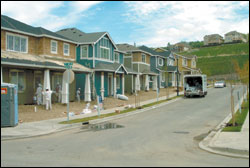WHAT IF THERE WERE a kind of Green Housekeeping seal for new homes that assured you they were built with environmental care? What if you could save the Earth just by moving to the Eastside, joining a “planned community,” and using your toilet flushes to water the golf course? Well, your dreams are being realized, thanks to a new public-private program called Built Green.
A joint project between King and Snohomish counties and the Master Builders (the trade group for the home construction industry), Built Green was launched a few years ago but is about to become a lot more visible. For example, the giant Issaquah Highlands development, which is slated to have 1,400 homes, a 3-million-square-foot Microsoft campus, a University Village- style shopping center, and its own I-90 interchange, is being constructed and marketed as a Built Green community. “We think it’s a great opportunity to distinguish our homes,” says Judd Kirk, head of Port Blakely Communities, the company behind this decades-in- the-making mini-city.
The object of the program, in part, is to encourage the use of environmental methods and materials. “Builders don’t like to be regulated,” says Built Green’s Katie Spataro, who works in the King County Solid Waste Department. “They tend to be more innovative when provided with incentives.” The incentive in Built Green is brand identity; if the builders meet certain eco-criteria, they win a seal of approval, one that will hopefully carry some cachet with consumers.
To that end, King County and the Master Builders are also aiming to raise public awareness of the program manning a Built Green booth at all the Seattle-area street fairs this summer, for instance. “This won’t go anywhere unless consumers are asking for it,” says Spataro.
BUT NO MATTER how Built Green is promoted to home buyers, the important question is how builders earn that badge. There are over 200 ways for a builder to accrue the points necessary for Built Green certification. These cover everything from the cleanliness of the building site (“Dispose of nonrecyclable hazardous waste at legally permitted facilities”1 point, “Construct tire wash”2 points) to home design (“Orient windows to make the best use of passive solar”2 points). A builder gets the same number of points (10) for framing a house with certified sustainable lumber or for providing a front porch and “minimizing” garage size. Nothing is specifically mandated; the builder just has to rack up those points.
How much of a challenge or environmental gain this represents is unclear. “The Washington energy codes cover a lot of the things that would be in the Built Green program, things like storm water management,” says Catherine Benotto, an architect with Weber Thompson who has worked on Issaquah Highlands. “It just requires a few tweaks to push it a little bit beyond the standard home.” Joe Coakley, vice president of Residential Development for Port Blakely, concedes that “the difference on energy is not as great as it was a year ago,” when the state tightened efficiency standards.
Yet Built Green also rewards the use of more durable materials, such as 50-year siding, and less-toxic paints, adhesives, etc., as well as recyclingnone of which is required by the state. At the Highlands, for example, all the excess asphalt, concrete, and broken rock generated during construction is being ground up and put back into the project.
One Built Green feature sure to give homeowners pause is that it’s self-regulated: Builders fill out their checklists on the honor system, with no independent verification. Says Dan Lungren of Stafford Homes, which is building at the Highlands: “If automakers self-tested cars for safety, you’d be like, ‘Well. . . . ‘” He says Stafford pays a consultant to verify its work.
You can understand why builders might feel lukewarm about Built Green. “None of our builders are doing this because they want to,” says Coakley. Among a half-dozen companies participating in Issaquah Highlands, only Stafford responded to a request for comment. Perhaps these companies are loath to discuss the program because of its implicit, and perhaps unfair, suggestion that the homes they’re selling elsewhere must be Built Brownnot such a great marketing slogan.
WILL BUILT Green catch on? William Boucher, vice president of Communications for Quadrant, the real-estate arm of Weyerhaeuser, says, “we are planning to be a little more aggressive in how we use the moniker” at its ongoing megaprojects Redmond Ridge and Snoqualmie Ridge. And Coakley says Port Blakely wants to see Built Green “ramped up. We want to create a four- star program.”
Others are less sanguine about home buyers’ willingness to spring for greener features. Lungren of Stafford Homes gives one example: “We offer a much more efficient furnace as an upgrade, but there’s a very, very small percentage of people who opt for that. They’re more inclined to put their money into a granite countertop.”








